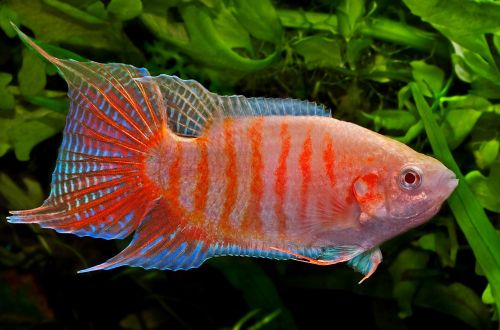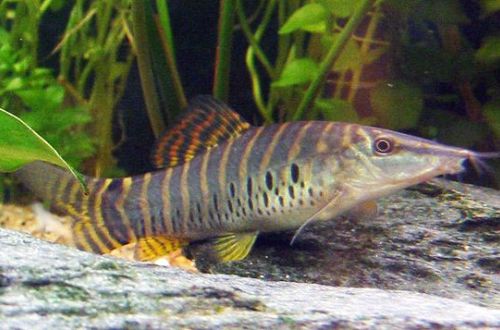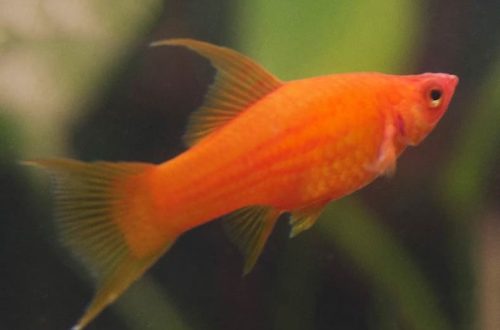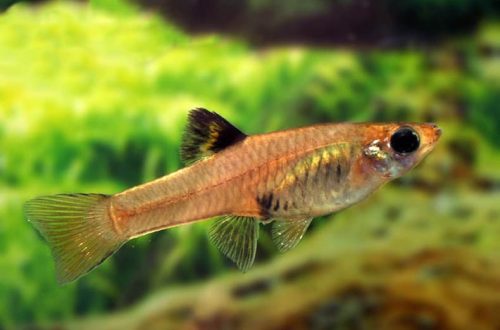
Macropod
The macropod or Paradise fish, scientific name Macropodus opercularis, belongs to the Osphronemidae family. One of the most beautiful aquarium fish found unchanged in the wild. The rest of the freshwater fish, similar in form and richness of colors, as a rule, are obtained through long selection.

This species was the first to be brought to Europe as an ornamental fish back in 1869. At that time, it was second only to the Goldfish in its popularity, and today the Paradise fish is still in demand among aquarists, despite a much greater variety of fish than a century and a half ago.
Contents
Habitat
The fish received a scientific description in 1758. Its discovery for science occurred during the study by Europeans of the flora and fauna of Southeast Asia. It is widely distributed in reservoirs and river systems on the east coast of modern China, as well as in Taiwan, Vietnam, Cambodia, Japan, and Malaysia. Currently bred outside of its natural range. Paradise fish can be found in North America, as well as on the island of Madagascar.
In nature, it lives in streams and tributaries of large rivers, swamps and wetlands, in flooded rice fields. They feed on everything that they can swallow, preference is given to meat products: insect larvae, worms, small fish, various invertebrates.
Description
This species has a small strong body, pointed fins. The caudal fin is large in comparison with the body, it can reach one third of the entire length of the fish. In the oral cavity there is a special organ in the form of a small sac pierced by many capillaries (labyrinth organ). With it, fish can absorb atmospheric oxygen directly from the air. The coloration is predominantly blue with bright vertical lines of red, in which the tail of the fish is also painted.
Food
They belong to omnivorous species, but prefer a protein diet: bloodworms, mosquito larvae, tubifex, etc., but they should not be the basis of their diet. In a home aquarium, you should feed dry food (flakes, granules) intended for Gourami, select a manufacturer that offers the largest amount of meat products in the composition. Feed once or twice a day is sufficient.
Maintenance and care
The macropod is extremely hardy, adapting to various environmental conditions. One or two fish require a small tank of about 80 liters, a lid is desirable in the design. Mandatory equipment includes a filter, an aerator and a lighting system. You can do without a heater, because the fish feel quite comfortable even at 16 ° C. The filter should be productive, but at the same time create as little water movement as possible. Fish do not tolerate strong currents, it causes stress and leads to severe fatigue.
In the design, one should adhere to the principle – one shelter per fish. Each individual in its natural habitat has its own territory, which they protect, so if there are two fish in the aquarium, place two equivalent shelters (snags, grottoes, etc.) in opposite parts of the tank. It will not be superfluous to plant several groups of strong plants with a powerful root system next to them. Floating plants are welcome. The substrate is recommended in a dark color, it contrasts with the color of the fish, thanks to which they look more impressive.
Social behavior
A rather aggressive species, first of all, this applies to males, the selection of neighbors is extremely difficult. The best option is a species aquarium where representatives of one species live, and in combination one male and one or more females. Males are extremely intolerant of each other, arrange fights for the territory, inflicting injuries. Females, on the contrary, are very friendly and can be found in a pack.
Sexual differences
Males are noticeably larger than females with large fins, brighter, saturated colors.
Breeding / breeding
Breeding is quite simple, but the male adds difficulties, during the construction of the nest and spawning, he becomes very aggressive towards females, at this time shelters become very useful. The use of a spawning aquarium is recommended, where the necessary conditions are recreated, it greatly simplifies the breeding process, because due to the behavior of the male, the female or females have to be constantly transplanted from him.
The stimulus for spawning is the addition of meat products (live or frozen) to the daily diet. The water level drops to 20 cm, the temperature should be raised to 26–29 ° C, the pH should be shifted to the acid side to 6.0. After some time, the female begins to fill with caviar, which noticeably rounds off, and the male starts building a nest from bubbles and pieces of plants, it is located under the largest leaf of a plant floating on the surface. If spawning takes place in the main aquarium, in which several females live and they have nowhere to hide, they should be planted in a separate tank until the nest is completed, otherwise during this period the male can not only cripple, but even kill the female.
When everything is ready, the male begins courtship, touches the chosen one, invites to the nest. An adult can produce up to 500 eggs, which are released into the water and are immediately fertilized. Since they are lighter than water, they float to the surface, where the male carefully picks them up and carries them to the nest. From this moment on, he becomes guardian of the masonry, the male will protect it from everyone, including females, which should be transplanted again.
The fry appear after 3-5 days, depending on the water parameters, the nest gradually disappears, and the male is ready to join the females. Parents and their offspring should be in separate tanks, since parental instincts end when the fry begin to swim freely, but the predatory instincts wake up. Feed the fry with microfeed, brine shrimp, ciliates.
Diseases
Incredibly hardy species, resistant to many diseases, in a balanced aquarium and good nutrition, disease outbreaks have not been observed. Read more about symptoms and treatments in the Aquarium Fish Diseases section.





